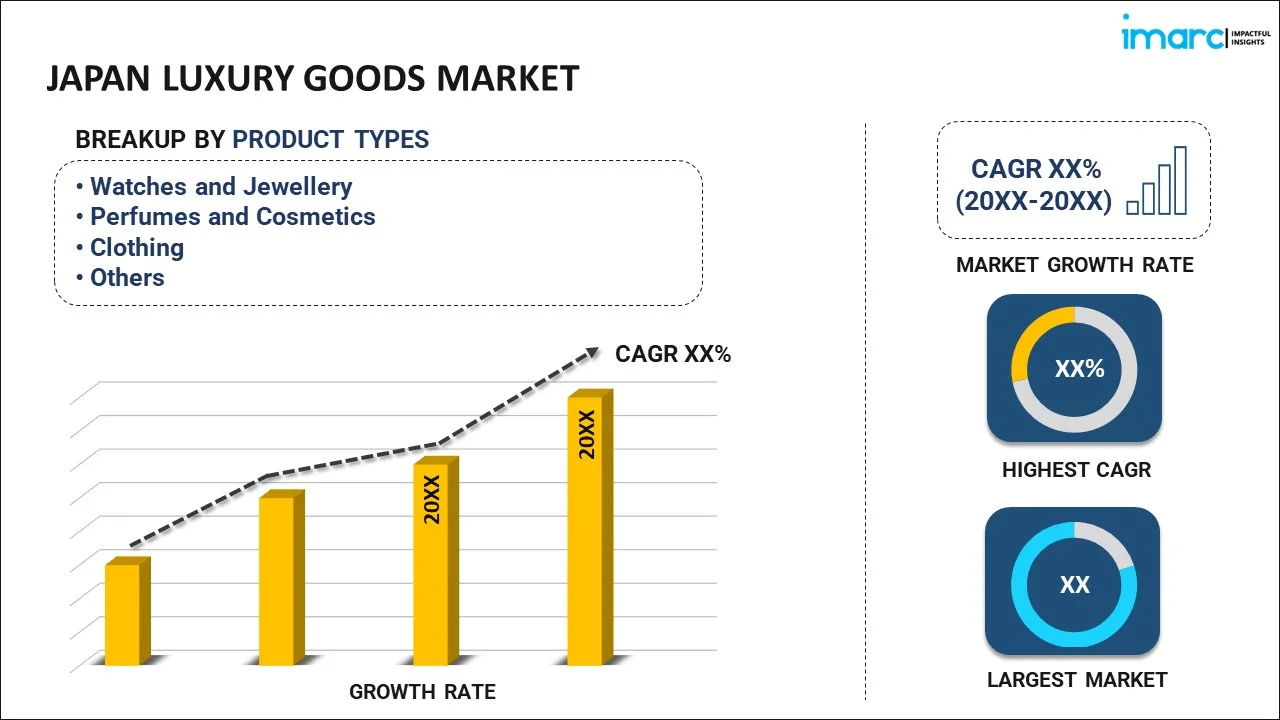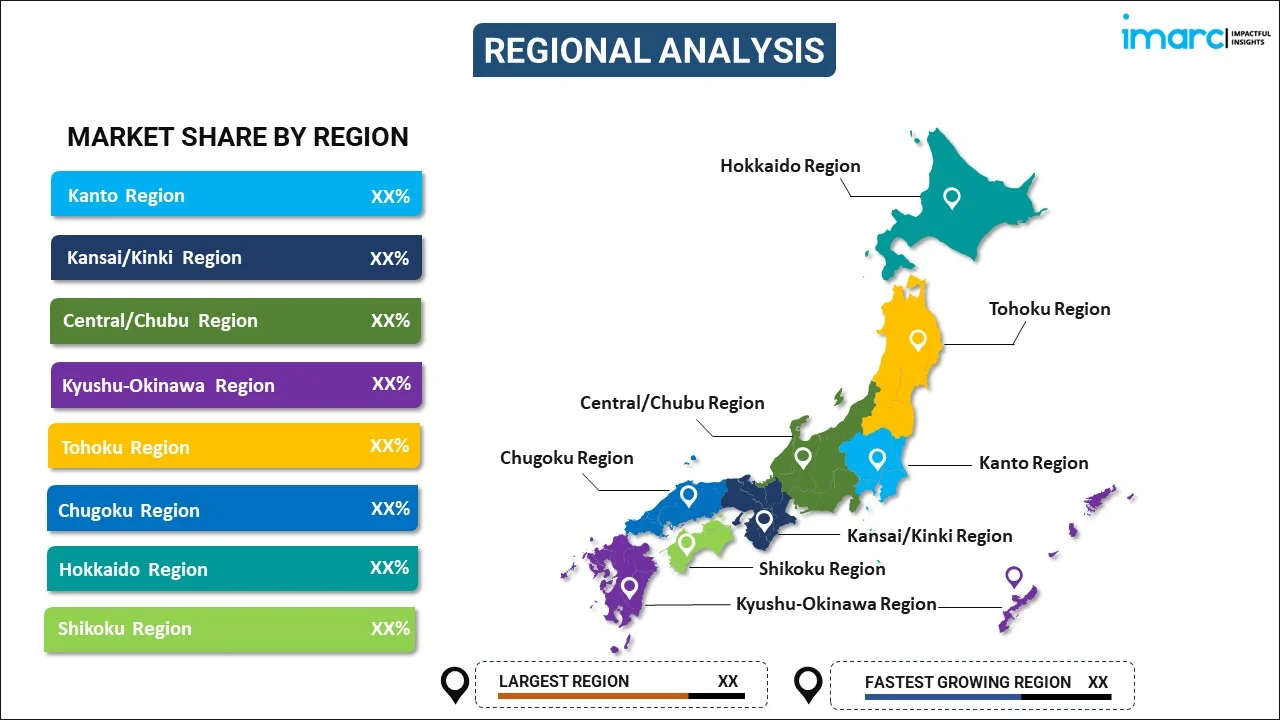
Japan Luxury Goods Market Report by Product Type (Watches and Jewellery, Perfumes and Cosmetics, Clothing, Bags/Purse, and Others), Distribution Channel (Offline, Online), End User (Women, Men), and Region 2025-2033
Market Overview:
Japan luxury goods market size reached USD 34.9 Billion in 2024. Looking forward, IMARC Group expects the market to reach USD 53.4 Billion by 2033, exhibiting a growth rate (CAGR) of 4.42% during 2025-2033. The increasing demand for personalized and customized luxury products that offer tailor-made or limited-edition items cater to consumers seeking a unique and personalized luxury experience, is driving the market.
|
Report Attribute
|
Key Statistics
|
|---|---|
|
Base Year
|
2024 |
|
Forecast Years
|
2025-2033
|
|
Historical Years
|
2019-2024
|
| Market Size in 2024 | USD 34.9 Billion |
| Market Forecast in 2033 | USD 53.4 Billion |
| Market Growth Rate (2025-2033) | 4.42% |
Luxury goods epitomize a blend of exquisite craftsmanship, opulent materials, and a distinct aura of exclusivity. These items, ranging from haute couture fashion to high-end automobiles and beyond, transcend mere functionality to become symbols of status and refined taste. Steeped in history, luxury goods have been coveted across cultures and epochs, evolving from traditional markers of aristocracy to contemporary emblems of success. Brands synonymous with luxury invest heavily in precision and detail, creating products that not only meet stringent quality standards but also embody a lifestyle. The allure of luxury extends beyond the tangible, encompassing the prestige associated with owning a rare, impeccably designed item. However, the definition of luxury is dynamic, influenced by societal shifts and evolving consumer values. In the modern era, sustainability and ethical practices are increasingly integral to the luxury narrative. Despite changes, the essence of luxury goods remains rooted in the extraordinary, inviting individuals to partake in a world where refinement and distinction intertwine, offering a glimpse into a life of unparalleled elegance.
Japan Luxury Goods Market Trends:
The luxury goods market in Japan is propelled by various factors that intricately weave together to create a robust and dynamic industry. Primarily, the regional surge in disposable income has fostered an increased appetite for premium products, driving the demand for luxury goods. Additionally, the growing influence of social media and celebrity endorsements serves as a potent catalyst, amplifying consumer aspirations and fueling the desire for high-end brands. Moreover, the evolving lifestyles and preferences of the burgeoning middle class contribute significantly to the expansion of the luxury market. As consumers increasingly seek unique and personalized experiences, luxury goods providers are compelled to innovate and differentiate their offerings, further stimulating market growth. The rapid urbanization trends have also played a pivotal role, connecting consumers across distances and exposing them to diverse luxury brands, thereby fostering a cosmopolitan appreciation for opulence. Furthermore, the strategic expansion of luxury brands into emerging markets, coupled with the advent of online retail platforms, has widened the accessibility of luxury goods, attracting a broader consumer base. This, in turn, is expected to drive the luxury goods market in Japan during the forecast period.
Japan Luxury Goods Market Segmentation:
IMARC Group provides an analysis of the key trends in each segment of the market, along with forecasts at the country level for 2025-2033. Our report has categorized the market based on product type, distribution channel, and end user.
Product Type Insights:

- Watches and Jewellery
- Perfumes and Cosmetics
- Clothing
- Bags/Purse
- Others
The report has provided a detailed breakup and analysis of the market based on the product type. This includes watches and jewellery, perfumes and cosmetics, clothing, bags/purse, and others.
Distribution Channel Insights:
- Offline
- Online
A detailed breakup and analysis of the market based on the distribution channel have also been provided in the report. This includes offline and online.
End User Insights:
- Women
- Men
The report has provided a detailed breakup and analysis of the market based on the end user. This includes women and men.
Regional Insights:

- Kanto Region
- Kansai/Kinki Region
- Central/ Chubu Region
- Kyushu-Okinawa Region
- Tohoku Region
- Chugoku Region
- Hokkaido Region
- Shikoku Region
The report has also provided a comprehensive analysis of all the major regional markets, which include Kanto Region, Kansai/Kinki Region, Central/ Chubu Region, Kyushu-Okinawa Region, Tohoku Region, Chugoku Region, Hokkaido Region, and Shikoku Region.
Competitive Landscape:
The market research report has also provided a comprehensive analysis of the competitive landscape in the market. Competitive analysis such as market structure, key player positioning, top winning strategies, competitive dashboard, and company evaluation quadrant has been covered in the report. Also, detailed profiles of all major companies have been provided.
Japan Luxury Goods Market Report Coverage:
| Report Features | Details |
|---|---|
| Base Year of the Analysis | 2024 |
| Historical Period | 2019-2024 |
| Forecast Period | 2025-2033 |
| Units | Billion USD |
| Scope of the Report | Exploration of Historical Trends and Market Outlook, Industry Catalysts and Challenges, Segment-Wise Historical and Future Market Assessment:
|
| Product Types Covered | Watches and Jewellery, Perfumes and Cosmetics, Clothing, Bags/Purse, Others |
| Distribution Channels Covered | Offline, Online |
| End Users Covered | Women, Men |
| Regions Covered | Kanto Region, Kansai/Kinki Region, Central/ Chubu Region, Kyushu-Okinawa Region, Tohoku Region, Chugoku Region, Hokkaido Region, Shikoku Region |
| Customization Scope | 10% Free Customization |
| Post-Sale Analyst Support | 10-12 Weeks |
| Delivery Format | PDF and Excel through Email (We can also provide the editable version of the report in PPT/Word format on special request) |
Key Questions Answered in This Report:
- How has the Japan luxury goods market performed so far and how will it perform in the coming years?
- What has been the impact of COVID-19 on the Japan luxury goods market?
- What is the breakup of the Japan luxury goods market on the basis of product type?
- What is the breakup of the Japan luxury goods market on the basis of distribution channel?
- What is the breakup of the Japan luxury goods market on the basis of end user?
- What are the various stages in the value chain of the Japan luxury goods market?
- What are the key driving factors and challenges in the Japan luxury goods?
- What is the structure of the Japan luxury goods market and who are the key players?
- What is the degree of competition in the Japan luxury goods market?
Key Benefits for Stakeholders:
- IMARC’s industry report offers a comprehensive quantitative analysis of various market segments, historical and current market trends, market forecasts, and dynamics of the Japan luxury goods market from 2019-2033.
- The research report provides the latest information on the market drivers, challenges, and opportunities in the Japan luxury goods market.
- Porter's five forces analysis assist stakeholders in assessing the impact of new entrants, competitive rivalry, supplier power, buyer power, and the threat of substitution. It helps stakeholders to analyze the level of competition within the Japan luxury goods industry and its attractiveness.
- Competitive landscape allows stakeholders to understand their competitive environment and provides an insight into the current positions of key players in the market.
Need more help?
- Speak to our experienced analysts for insights on the current market scenarios.
- Include additional segments and countries to customize the report as per your requirement.
- Gain an unparalleled competitive advantage in your domain by understanding how to utilize the report and positively impacting your operations and revenue.
- For further assistance, please connect with our analysts.
 Request Customization
Request Customization
 Speak to an Analyst
Speak to an Analyst
 Request Brochure
Request Brochure
 Inquire Before Buying
Inquire Before Buying




.webp)




.webp)












